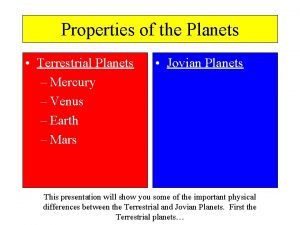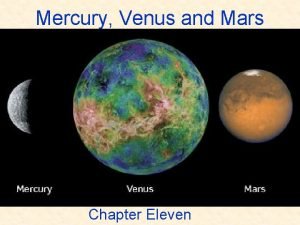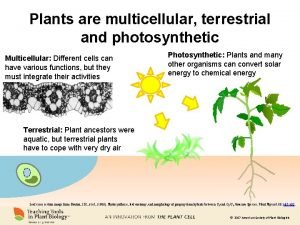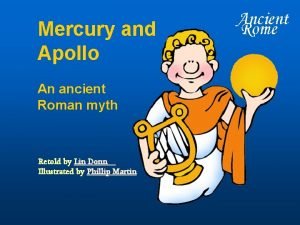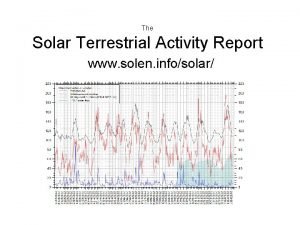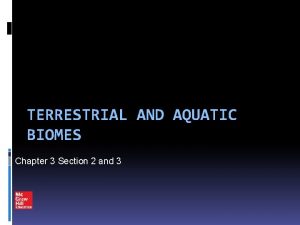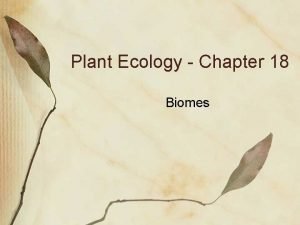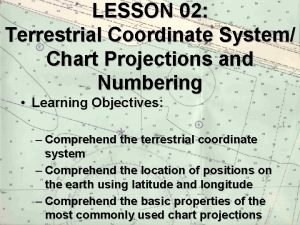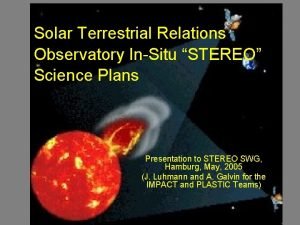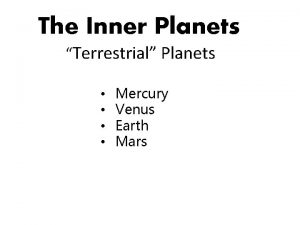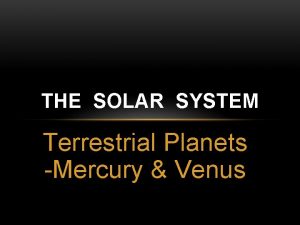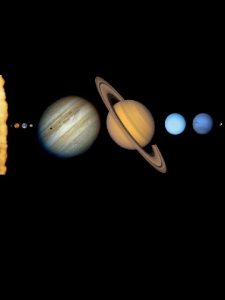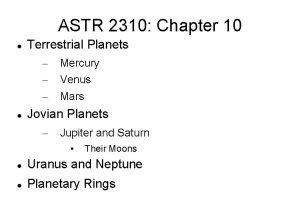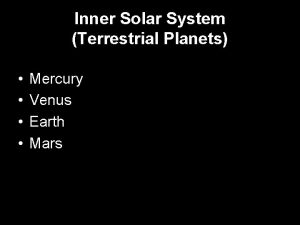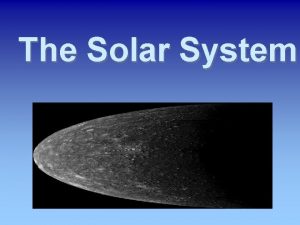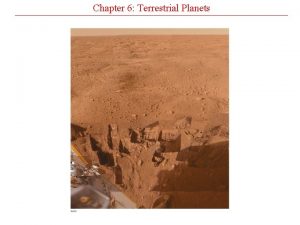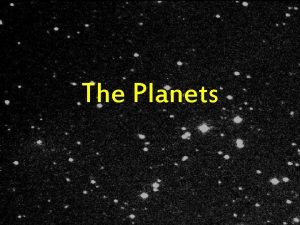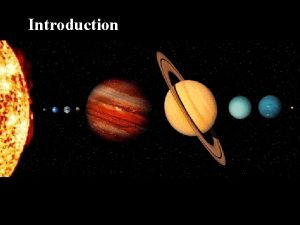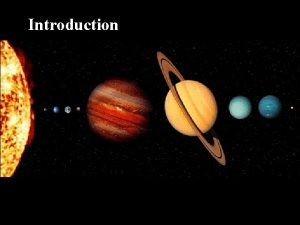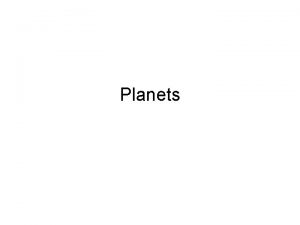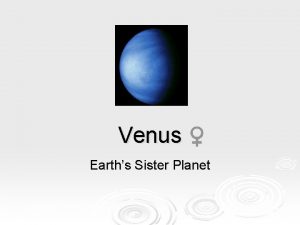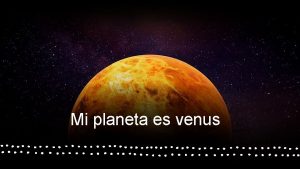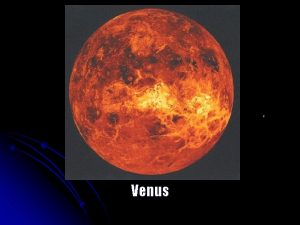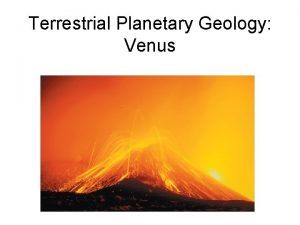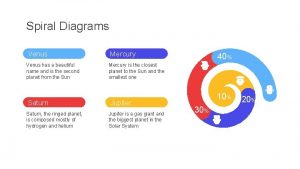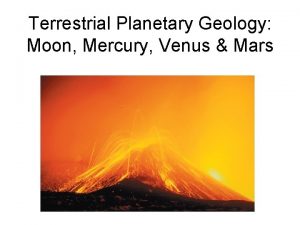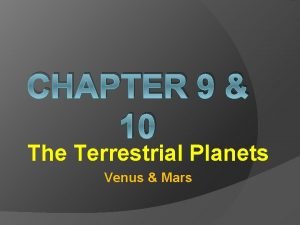The Terrestrial Planets Part I Mercury and Venus
































- Slides: 32

The Terrestrial Planets, Part I Mercury and Venus

MERCURY The Winged Messenger

Physical Data l l l Diameter: 4, 864 km (0. 382 Dearth) Mass: 3. 33 x 1026 g (0. 0558 Mearth) Density: 5. 50 g/cm 3 Rotation Period: 58. 65 days o Tilt of Axis: 0 Surface Temperature: 700 K (day side) 100 K (dark side).

Physical Data l l l Orbital Semi-Major Axis: 0. 387 AU Perihelion Distance: 0. 308 AU Aphelion Distance: 0. 467 AU Orbital Period : 87. 97 days (0. 241 years) o Orbital Inclination: 7. 00 Orbital Eccentricity: 0. 206 Surface Gravity: 0. 38 Earth gravity

Physical Data l o Maximum Elongation: 28 (aphelion) o 18 (perihelion) o 23 (average) Satellites: None Magnetic Field: 1% strength of Earth’s. l l

Mercury Apparitions l l l At western elongation, Mercury is visible in the morning before dawn (“morning star”). At eastern elongation, Mercury is visible in the evening after sunset (“evening star”). Mercury appears to change in size, and has phases like the Moon.

Mercury’s 3: 2 Resonance l l l Once thought to be synchronous Mercury rotates 3 times for every two orbits One Mercury “day” lasts two Mercurian years!

Mercury’s Interior l l Mercury is the most iron-rich planet in the solar system. Of all the planets, Mercury has the largest core relative to its overall volume (42%, 16% for Earth)

Mercury’s Magnetic Field l 1% Earth’s Magnetic Field SUN

Mercury’s Surface l Mercury appears very Moon-like

Mercury’s Surface l Craters

Mercury’s Surface l Lobate Scarps

Mercury’s Surface l Caloris Basin - 1300 km diameter crater

Mercury’s Surface l “Weird” (or Jumbled) Terrain l Polar caps?

Other Topics: l l Precession of perihelion Radar measurements of Mercury’s rotation

VENUS The Goddess of Love

Physical Data l l l Diameter: 12, 104 km (0. 951 Dearth) Mass: 4. 87 x 1027 g (0. 815 Mearth) Density: 5. 30 g/cm 3 Rotation Period: 243 days o Tilt of Axis: 177. 4 (retrograde) Suface Temperature: 750 K

Physical Data l l l Orbital semi-major axis: 0. 723 AU Orbital period: 224. 70 days (0. 615 years) o Orbital inclination: 3. 39 Orbital Eccentricity: 0. 007 o Maximun Elongation: 48 Surface Gravity: 0. 90 Earth gravity

Physical Data l Satellites: None Magnetic Field: No l Surface Pressure: 90 times Earth’s! l

Venus Apparitions l l l At western elongation, Venus is visible in the morning before dawn (“morning star”). At eastern elongation, Venus is visible in the evening after sunset (“evening star”). Venus appears to change in size, and has phases like the Moon

Clouds of Venus l l l Clouds whiz aroud Venus at 300 km/hr. At this speed, a cloud can circle Venus in only four days. Clouds are composed of mostly sulfuric acid and water.

The Atmosphere of Venus l l 96. 5% Carbon Dioxide 3% Nitrogen Traces of Other Gases: 0. 019% Sulfur Dioxide 0. 01% Water Vapor 0. 007% Argon Hydrochloric acid, Hydroflouric acid Atmospheric Pressure 90 x Earth’s

105 km Venus’ Atmosphere 75 km l Clouds contain sulfuric acid and water Cloud tops appear Altitude yellow from sulfur dust Temperature reaches a maximum at the surface of about 750 K o (900 F) Top of Clouds Upper Cloud Deck 60 km l Droplets of Sulfuric Acid & Water Haze Layer Lower Cloud Deck 45 km l Sulfuric Acid& Water and Sulfur Crystals Clouds T hin Out 30 km Clear, Hot Atmosphere 15 km 0 K 200 K 400 K 600 K Temperature 800 K

Why is Venus So Hot?

Venus’ Interior l l Core - 12% total volume of planet Venus CRUST ( silicates) Molten core? 6052 km 3616 km l Thin crust, with continent sized features. CORE ( iron-nickel ) MANTLE ( olivine )

Soviet Venera Missions l First Surface Photographs, 1970 Photo from Venera 13

The Magellan Mission

Magellan Surface Imagery l l Suface Features: Impact Craters Lava Flows Volcanic Calderas Volcanoes Peculiar to Venus: Coronae, Pancake Domes, Ticks, Graph Paper Regions.

Venus’ Surface l Graph Paper Regions

Venus’ Surface l “The Tick”

Venus’ Surface l Coronae

Venus’ Surface l Pancake Domes
 What are jovian planets made of
What are jovian planets made of My very excited mother just
My very excited mother just Terrestrial planets surface
Terrestrial planets surface What is the 2nd smallest planet in our solar system
What is the 2nd smallest planet in our solar system Inner terrestrial planets
Inner terrestrial planets The terrestrial planet
The terrestrial planet What separates inner and outer planets
What separates inner and outer planets What is each planet made of
What is each planet made of Mercury venus
Mercury venus Mercury venus
Mercury venus 9 planets
9 planets Photosynthetic multicellular and terrestrial
Photosynthetic multicellular and terrestrial Aquatic vs terrestrial
Aquatic vs terrestrial Difference between mercury cell and diaphragm cell
Difference between mercury cell and diaphragm cell Mercury and apollo myth
Mercury and apollo myth Element name
Element name Solen.info
Solen.info What is a terrestrial biome
What is a terrestrial biome Chapter 3 section 2 terrestrial biomes
Chapter 3 section 2 terrestrial biomes Terrestrial navigation example
Terrestrial navigation example Terrestrial soil
Terrestrial soil What are biomes defined by
What are biomes defined by Terrestrial coordinate system
Terrestrial coordinate system Food web examples
Food web examples Overlapping food chains
Overlapping food chains Pond succession
Pond succession Human impact on terrestrial ecosystems
Human impact on terrestrial ecosystems Events 2022
Events 2022 Terrestrial food production
Terrestrial food production Solar terrestrial relations observatory
Solar terrestrial relations observatory Gymnosperms
Gymnosperms Terrestrial habitat
Terrestrial habitat Umts terrestrial radio access
Umts terrestrial radio access





